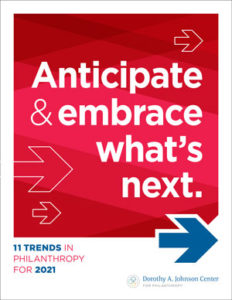Philanthropy and Government Play Increasingly Overlapping Roles in the Public Sphere


 The preamble of the U.S. Constitution states that “We the People” first set out to form a government and establish laws “in Order to form a more perfect Union.” We do this together, and therefore we define government as public action for the public good.
The preamble of the U.S. Constitution states that “We the People” first set out to form a government and establish laws “in Order to form a more perfect Union.” We do this together, and therefore we define government as public action for the public good.
Yet government is not alone in this aim to advance the public good. At the Johnson Center, we define philanthropy broadly as private action for the public good. Our definition is grounded in the word’s Greek etymology — it means “love for humankind” — and we use the term broadly to refer to the entire ecosystem of nonprofits, foundations, and donors.
Philanthropy and government have always worked in close proximity. Historically, nonprofits often started programs in reaction to community-level needs that, when successful, the government would absorb. Examples of these transitions can be found in every arena of public life — in education, sanitation, public safety, healthcare, etc.
Beginning in the 1960s, that dynamic began to shift. Under the auspices of the War on Poverty, local, state, and federal offices began increasingly outsourcing their service delivery to nonprofits through contracts, grants, and other means (Smith, 2009). As of 2015 (the most recent year of available data), annual federal outlays to nonprofits top $491 billion, while state and local governments distribute another $187 billion to the sector. By contrast, foundations contribute only $44 billion annually (Pratt & Aanestad, 2020).
“Multi-sector partnerships are likely the only route for achieving real progress.”
By replacing direct service delivery with external providers in the ensuing years, governments continued to pull back from spaces where they had traditionally taken a lead. Simultaneously, since the 1970s, philanthropy (and philanthropists) have been taking an increasing interest in targeting public policy and public opinion. A 2020 report from the Center for Effective Philanthropy notes that today, fully 90% of foundations say they are actively seeking to influence public policy through grantmaking and other activities (Orensten, Buteau, Martin, & Gehling).
The relationship between government and philanthropy has never been simple or one-way. Today, it is more complex than ever.
Examples of the increasingly blurring boundaries between philanthropy and government often fall into one of two categories:
Two tech entrepreneurs-cum-philanthropists, Bill Gates and Tim Gill offer telling examples of the first type of overlap. Gill’s $422 million’ worth of support for LGBTQ rights fueled the movement that fundamentally changed public policy and made Marriage Equality a reality in 2015 (Kroll, 2017). For his part, Gates — both as an individual donor and via the Bill & Melinda Gates Foundation — has dedicated tens of millions of dollars toward supporting specific public education reforms in the U.S., including charter schools and the Common Core State Standards.
In addition to the historical examples of shifting responsibilities mentioned earlier, newer examples suggest that the second type of overlap is getting even more complicated. As we outlined in 11 Trends in Philanthropy for 2018 (Caldwell), Michigan has been ground zero for some nationally recognized examples of this, including:
Both types of government-philanthropy interaction and boundary shifting have shown up in 2020. Consider the federal government’s and philanthropy’s contrasting responses to the COVID-19 crisis. In the absence of a coordinated federal response for testing and contact tracing, philanthropic actors like the Rockefeller Foundation have taken on this work themselves (Eban, 2020). In April, Rockefeller published a “1-3-30 Action Plan” to increase testing to 30 million tests per week by October. In July, they issued an update to the plan and called on the federal government to set aside partisan politics to focus on the crisis. While the foundation has announced a $50 million commitment to 1-3-30, its estimated total cost for this work is $75 billion. Many foundations, individuals, cities, and towns are stepping forward to contribute and take part. The Coronavirus Aid, Relief, and Economic Security (CARES) Act include $25 billion for testing, but according to the action plan, another $75 billion is needed and further relief has been stalled.
In 2021, this increased complexity will surely continue. And it is likely to affect how Americans view both philanthropy and government and their roles in solving social challenges for decades to come.
The rise of systems-change thinking may be one of the forces behind these shifting roles. Communities are increasingly recognizing that endemic social challenges like poverty, racism, and poor educational outcomes do not exist in a vacuum — and they won’t be solved by one sector or one institution. Multi-sector partnerships are likely the only route for achieving real progress (e.g., TheBMJ).
Ongoing budgetary crises at the state and local levels are another force behind shifting sector boundaries. Philanthropy is more often stepping in to cover the costs of services and infrastructural repairs when governments run out of cash — and that need isn’t likely to disappear soon. The COVID-19 crisis is already exacerbating budgetary shortfalls for both governments and nonprofits, and will likely continue to do so for several years (Davidson & Harrison, 2020).
Declining public trust — especially in government — is another factor. In the 2020 Edelman Trust Barometer, only 39% of the U.S. general public reported trusting the government to “do what is right,” versus 50% who see NGOs that way. (pp. 38, 40). The Pew Research Center found even more dismal numbers in 2019: only 17% of Americans reported they trust the federal government to do the right thing “just about always” or “most of the time.” That percentage hasn’t topped 30% since before the Great Recession.
With major budget gaps, historic partisanship, and a staggering lack of public trust, government and philanthropy perhaps need each other more than ever to foster innovation and cultural movements our society needs in order to achieve equitable, thriving communities.
As Hans Zeiger, a state legislator from Washington, wrote after the 2016 National Leadership Forum,
there should be room to accommodate the evolution of government and philanthropy in an age of rapid change. The goal should be to strike the right balance, and when the outlines and outlooks of markets, civil society, technology, and communications are changing, government and philanthropy can be expected to adapt. It’s a conversation worth continuing. (2016, para. 11)
Caldwell, K. (2018, January). Governments and nonprofits: New partnerships or paradigm shifts? 11 trends in philanthropy for 2018. Dorothy A. Johnson Center for Philanthropy. https://johnsoncenter.org/blog/governments-and-nonprofits-new-partnerships-or-paradigm-shifts
Davidson, K., & Harrison, D. (2020, August 12). Coronavirus-hit state budgets create a drag on recovery. The Wall Street Journal. https://www.wsj.com/articles/coronavirus-hit-state-budgets-create-a-drag-on-u-s-recovery-11597224600
Detroit Historical Society. (n.d.) Grand Bargain. Encyclopedia of Detroit. https://detroithistorical.org/learn/encyclopedia-of-detroit/grand-bargain
Devereaux, B. (2020, January 23). $28M gift added to Kalamazoo Foundation for excellence fund. MLive. https://www.mlive.com/news/kalamazoo/2020/01/28m-gift-added-to-kalamazoo-foundation-for-excellence-fund.html
Eban, K. (2020, June 30). How Jared Kushner’s secret testing plan “went poof into thin air”. Vanity Fair. https://www.vanityfair.com/news/2020/07/how-jared-kushners-secret-testing-plan-went-poof-into-thin-air
Edelman. (2020, January 19). 2020 Edelman Trust Barometer. https://cdn2.hubspot.net/hubfs/440941/Trust%20Barometer%202020/2020%20Edelman%20Trust%20Barometer%20Global%20Report.pdf
Kroll, A. (2017, June 23). Meet the megadonor behind the LGBTQ rights movement. Rolling Stone. https://www.rollingstone.com/politics/politics-features/meet-the-megadonor-behind-the-lgbtq-rights-movement-193996
Orensten, N., Buteau, E., Martin, H., & Gehling, K. (2020). Policy influence: What foundations are doing and why. Center for Effective Philanthropy. http://cep.org/wp-content/uploads/2020/06/CEP_PublicPolicy.pdf
Pew Research Center. (2019, April 11). Public trust in government: 1958–2019. https://www.pewresearch.org/politics/2019/04/11/public-trust-in-government-1958-2019
Pratt, J., & Aanestad, K. (2020, February 24). NPQ’s illustrated nonprofit economy, 3rd edition. Nonprofit Quarterly. https://nonprofitquarterly.org/infographics/npqs-illustrated-nonprofit-economy
The Rockefeller Foundation. (2020, July 16). National Covid-9 testing & tracing action plan. https://www.rockefellerfoundation.org/wp-content/uploads/2020/07/TheRockefellerFoundation_TestingEcosystem_7_23.pdf
Smith, S. R. (2009, September 21). Government and nonprofits: Turning points, challenges, and opportunities. Nonprofit Quarterly. https://nonprofitquarterly.org/government-and-nonprofits-turning-points-challenges-and-opportunities
Zeiger, H. (2016, March 24). Blurring lines between government and philanthropy. Philanthropy Daily. https://www.philanthropydaily.com/blurring-lines-between-government-and-philanthropy-2